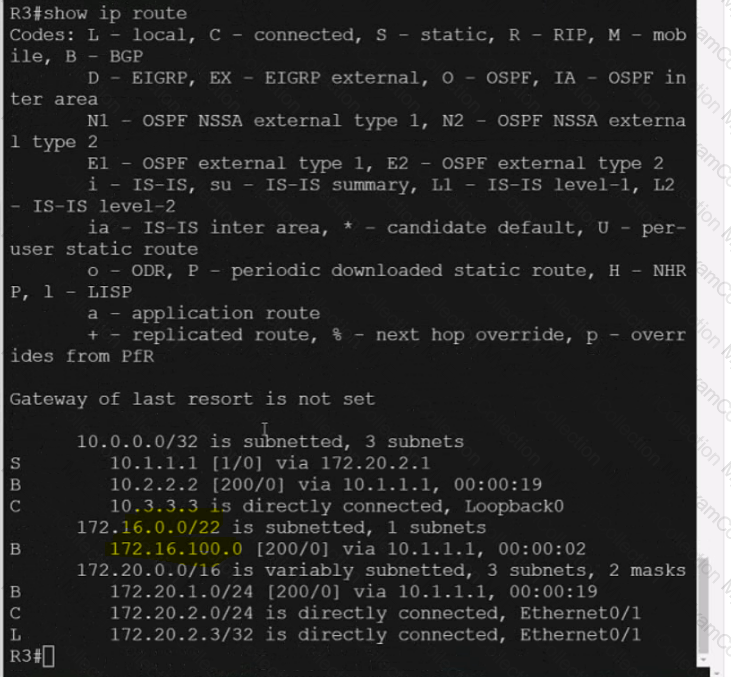
Refer to the exhibit A network engineer installed a new router (router 3) at the regional hub running MPLS services for scalability Router 3 is connected to the 10.44 4.0,'24. 10.44 5.024. 10 44.6.0/24. and 10 44 7 0/24 subnets The new router has been configured for OSPF area 2. and it is advertising the four connected networks. The engineer noticed that the same networks are listed as interarea summary routes, and they are being flooded into each area on the area borders Which action resolves the issue?

Refer to the exhibit. Company A established BGP sessions with several ISPs. A network engineer at the company must filter out all traffic except for routes that transit AS 152. The engineer configured the filtering policy “permit _152S_(_[0.9])†on R1, but after applying the configuration, the engineer notices that other routes are still visible. Which action resolves the issue?

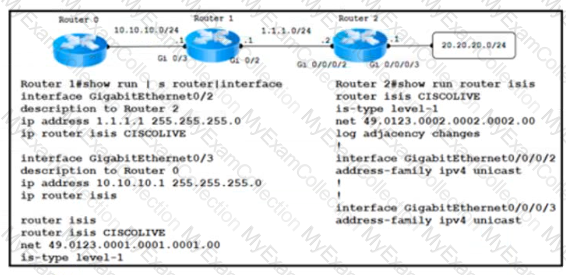
Refer to the exhibit. An engineer is troubleshooting a network routing issue on this IS-IS network situated at the customer's regional hub. Router 2 that runs Cisco IOS XR Software cannot see the network 10.1.1.0/24 on router 1. The Layer 2 encapsulations are correct. The ARP connectivity for the Ethernet interface that runs IS-IS is working. Which action resolves the issue?
Refer to the exhibit.
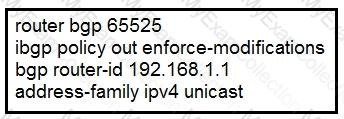
Router 1 is a core ABR in a Cisco Unified MPLS environment. All of the router 1 BGP
peers are established, but traffic between customers is failing. Which BGP configuration must be added to the configuration?
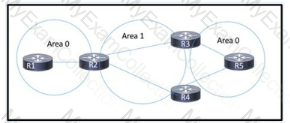
Refer to the exhibit. A network engineer just replaced five routers on this OSPF network. When the routing protocol is brought up, R5 cannot reach routes that originate on R1. The engineer verified that all connected links have established neighbor relationships. R5 reaches routes originating on R3 and R4. Which action resolves the issue?
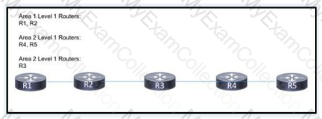
Refer to the exhibit. This network is deployed with all connected links configured to run IS-IS. The routing protocol is enacted globally on each router, and the network engineer expects full routing Information to be shared among all routers. R5 is receiving routes from R4 but is missing routes from R1. Which action corrects the issue so that all routes are shared among the routers?
Refer to the exhibit.
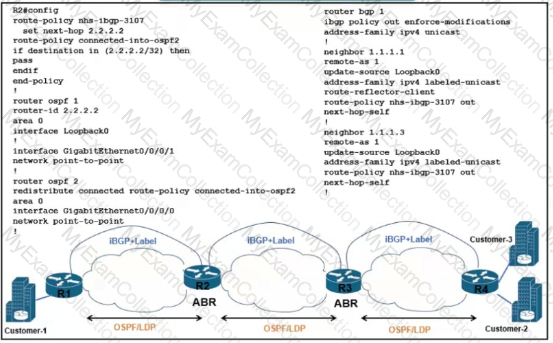
There is a connectivity issue between Customer-1 and Customer-2 File servers between the customers cannot send critical data R3 routes are missing from the routing table on the Customer-1 router All interlaces on Customer-1 are up Which configuration must be applied to router R2 to correct the problem?
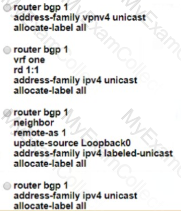
A network operator working for a telecommunication company with an employee id: 4074:92:707 is planning to implement the Nonstop Forwarding (NSR) feature on the customer’s core network. After getting the configuration ready for NSR. on which router should the operator implement NSR changes?
Refer to the exhibit.
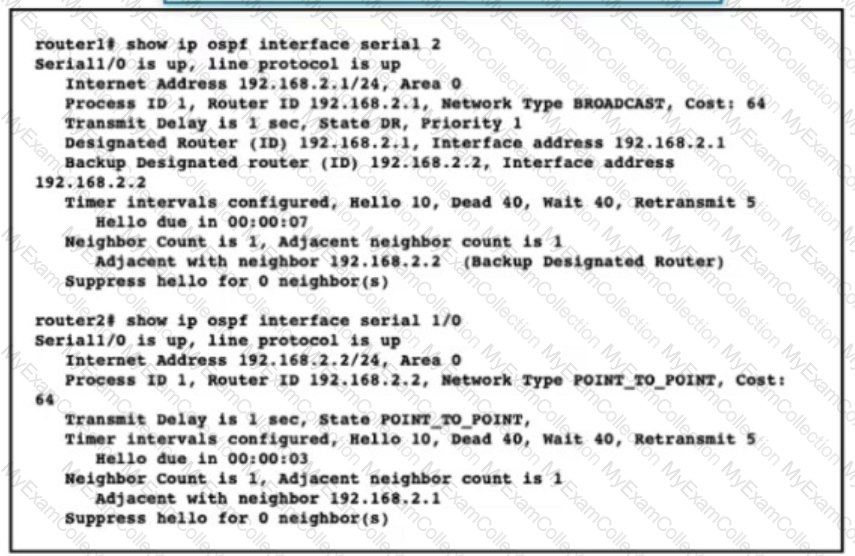
Router 1 and Router2 have shared routes in the OSPF database but the routes are missing from their routing tables. Checking me prefix-list configuration on both routers, the engineer confirmed all networks are allowed What action should the engineer take to fa the problem?
Which difference must an engineer consider when Implementing Inter-domain and Intra-domain multicast routing on the network?
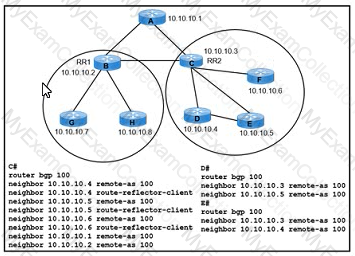
Refer to the exhibit While troubleshooting a networking issue an engineer identified a suboptimal communication issue on route reflector RR2 In the current environment
- Router A is a non-route-reflector client for RR1 and RR2
- Routers D and E are directly connected iBGP peers.
- Router F is not an iBGP peer of routers D and E
Which action resolves the issue?
Refer to the exhibit.
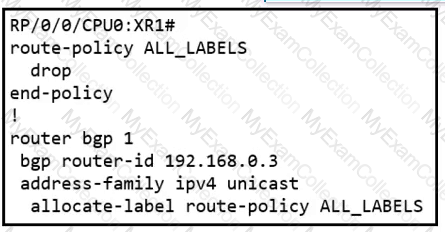
A network operator is working to deploy a Unified BGP design and allow it to be available only in selected markets and services in the future. The label allocation is not functioning as desired. Which action will fix the issue?

Refer to the exhibit. Mid-sized company Z connected two branch offices via a multicast-enabled ISP using the BGP routing protocol. PIM was implemented to support multicast streaming between the branches via MSDP Client A cannot connect to the multicast stream source of company Z. The network engineer ran a debug on the edge of the network as shown. Which action resolves the issue?
Refer to the exhibit.
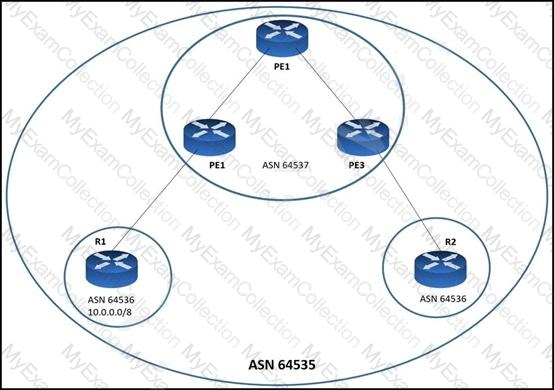
A network engineer has divided AS into confederations. Due to repeated ASN, when the 10.0 0.0/8 prefix from R1 arrives to R2, BGP automatically rejects it. What should the engineer do to fix the problem so that BGP allows that prefix on R2?
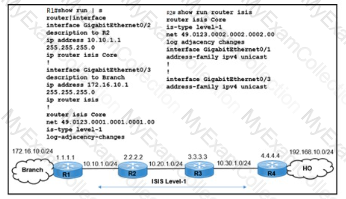
Refer to the exhibit. Users at the branch office on R1 reported issue with an application at the home office on R4. While troubleshooting the issue, a network engineer determined that
- The branch-office users can connect to the home office.
- The IS-IS adjacencies between R1 and R2 and R1 and the branch office are up.
- Traffic from R1 to the R2 10.20.1.0/24 network is moving normally.
- The application at the home office is experiencing packet drops on the connection to the Branch, and R3 cannot reach the R1 172.16.10.0/24 network.
Which action resolves the issues?
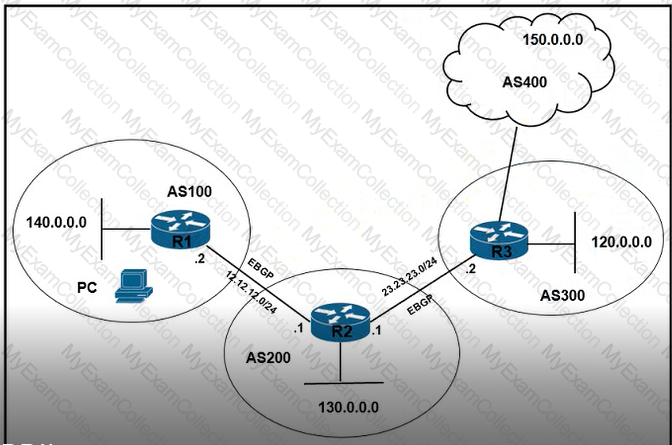
Refer to the exhibit. Excessive routes are flooding from network 150.0.0.0 into AS100. Internet traffic between AS400 and AS300 is working normally. No route controlling mechanism is applied on incoming and outgoing traffic Which configuration resolves the issue?
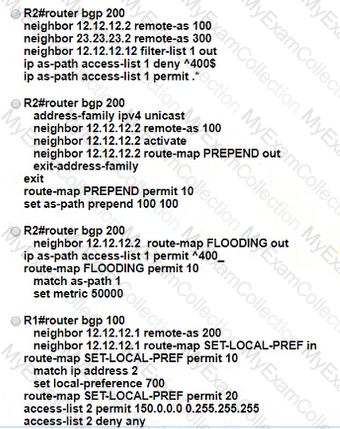
A network consultant is troubleshooting IS-IS instances to identify why a routing domains is having communication problems between the two instances. Which description of the possible cause of issues in the routing domain is true?
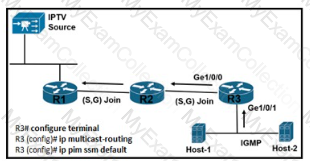
Refer to the exhibit. A network engineer is configuring router R3 to handle multicast streams, but Host-2 cannot send subscriptions messages to the IPTV source. Which configuration must the engineer apply to router R3 so it passes the IPTV stream to Host-2?
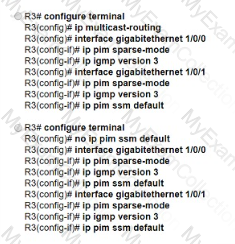
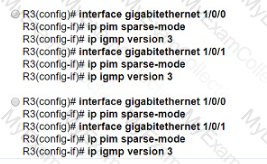
Refer to the exhibit.
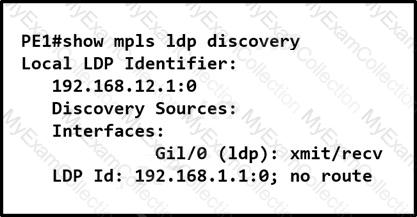
An administrator is troubleshooting network issues on a customer’s network PE1 cannot form an LDP relationship with PE2 using LDP ID 192 168.1.1. Due to this connectivity issue, the customer’s routes behind both PE routers cannot be exchanged. Which action must the administrator take to correct the problem?
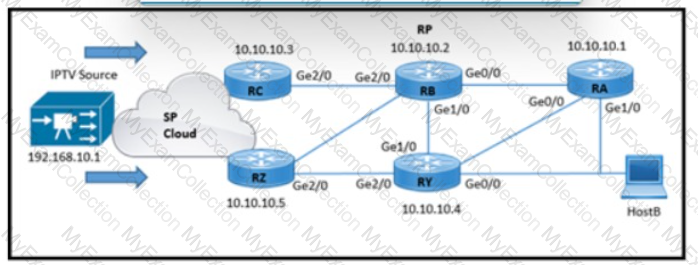
Refer to the exhibit. HostB receives an IPTV traffic stream from the multicast source at 192.168 10.1. When router RB is powered down, it impacts multicast traffic forwarding to downstream peers. The RA and RB routers reside in the same physical location. Which two configurations must be implemented so that HostB receives the multicast stream even when RB is powered down? (Choose two )
Level 3 switch SW1 is part of an EIGRP enabled network located at the edge of an area. Cisco Express Forwarding and SSO are enabled on the router. A network engineer must minimize the downtime of data-transmit services in the network. HSRP group 2 has already been configured with standby preempt delay minimum 2 and standby timers 140. Which additional action must the engineer take on SW1 to suppress routing flaps for 2 minutes?
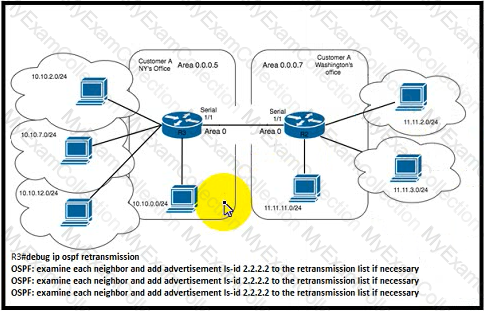
Refer to the exhibit. Customer A is a small media company with two offices connected by a 512 Kbps line. Their NY office is connected to several external partners by static routes on router R3. VoIP services use VoIP codec G729 Users reported poor voice quality and slow data transfer between the offices A network engineer configured ip tcp header-compression iphc-format on R2 and R3 routers Which additional action must the engineer take to fix the issue?
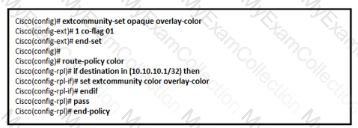
Refer to the exhibit. An engineer is troubleshooting an issue with traffic steering using the color-only automated steering mechanism. BGP is failing to automatically steer traffic into an SR policy with the given color of a route, regardless of the next hop. The layer 2 configuration is correct, and the physical connection between the devices is working normally. Whch additional command sequence must the engineer add to correct the issue?
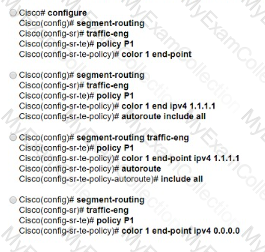
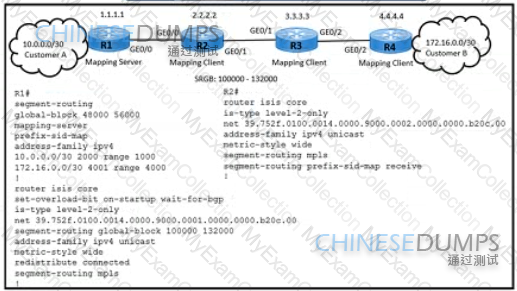
Refer to the exhibit. Customer A and customer B are connecting through a service provider network with these requirements
- R1 acts as the mapping server to connect 10 0 0.0/30 and 172.16.0.0/30 networks
- R1 and R2 are using nondefault SRG8 range to allocate SID.
- R2 ads as the mapping client for transient traffic originating from customer A
Which configuration meets the requirements?
Refer to the exhibit
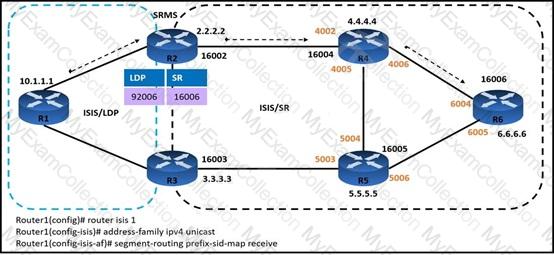
An engineer is configuring service traffic from router R1 to R6 as shown. Which additional configuration must the engineer implement so that the LDP and SR domains will participate and interwork with each other?
An ISP has an MPLS VPN-based network with 12 PE routers. How many peerings are required between the 12 routers if the engineer has not configured route reflectors?
Which two differences should be considered when deciding whether to implement to implement routing policies or route maps? (Choose two.)
The ISP_A network is configured with PIMv2 with sparse mode. The engineering team at ISP_A must implement multicast support following RFC 5059 in the network. The RP priority will be 0, and the solution must require limited supervision from the operations team. Which action must the team take to meet the requirements?
Refer to the exhibit.
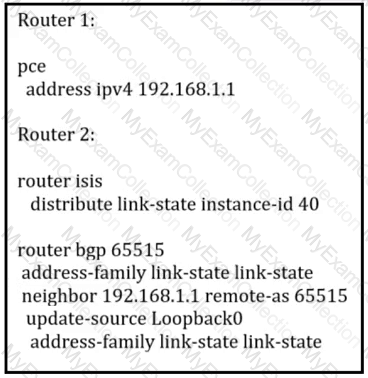
What is the relationship between Router 1 and Router 2?
Refer to the exhibit.
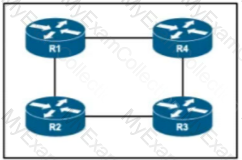
All routers on this network have been configured with P1M-SM and R1 is the rendezvous point However, when asymmetric routing is implemented to modify link usage the network begins to drop certain multicast traffic Which action corrects the problem?
Refer to the exhibit.
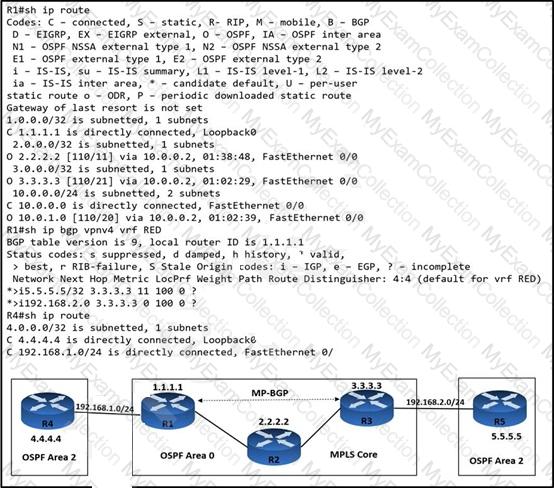
An engineer is troubleshooting connectivity issues on the MPLS core network. A customer connected through R4 cannot reach the OSPF domain on R5. While checking the routing table of R1, the engineer cannot see all the routes from R3 and R5. Which task must the engineer perform so that R4 is able to reach R5?
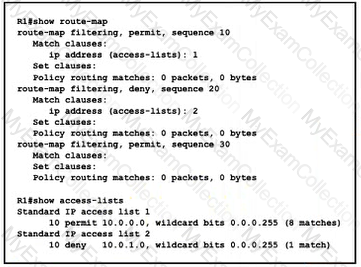
Refer to the exhibit A network engineer configured the redistribute connected subnets route-map filtering command on R1 to redistribute connected interfaces to the OSPF process The engineer also wants to filter out IP address 10 0 1 0/24. but the prefix still appears in the routing tables of the other routers on the network. Which action corrects the problem?
Which lag command is used within route-map to redistribute routes that match with routes tagged with the specified tag numbers?
Refer to the exhibit.
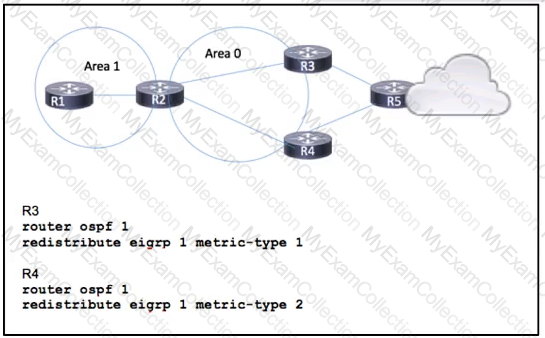
Routers R1, R2. R3, and R4 have been configured to run OSPF. and router R5 is running EIGRP Traffic from R1 to R5 is expected to pass via R4. but OSPF routing has calculated the best path via R3. Which action corrects the problem?
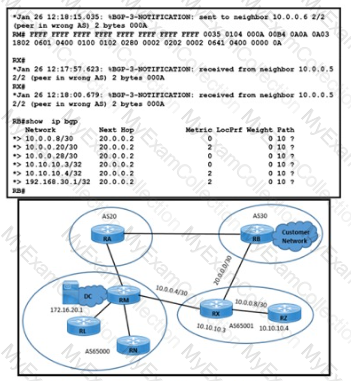
Refer to the exhibit. An engineer working for a private telecommunication company with an employee id: 4233:46:364 notices that the customer network going through AS30-AS65001-AS65000 is experiencing packet drops when it accesses an application at 172.16.20.1/32 In the DC cloud. The BGP link between AS20 and AS30 is inaccessible because of a fiber cut. Routers RL, RN, and RZ are configured with confederation identifier 10. Which action resolves this Issue?
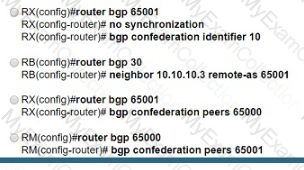

Refer to the exhibit. Router R1 is expected to receive routes that originate from AS 65547 only. However, R1 is receiving routes from AS 65547 and several other ASs that are directly attached to it. Which change to the AS path permit filter corrects the problem?
Refer to the exhibits.
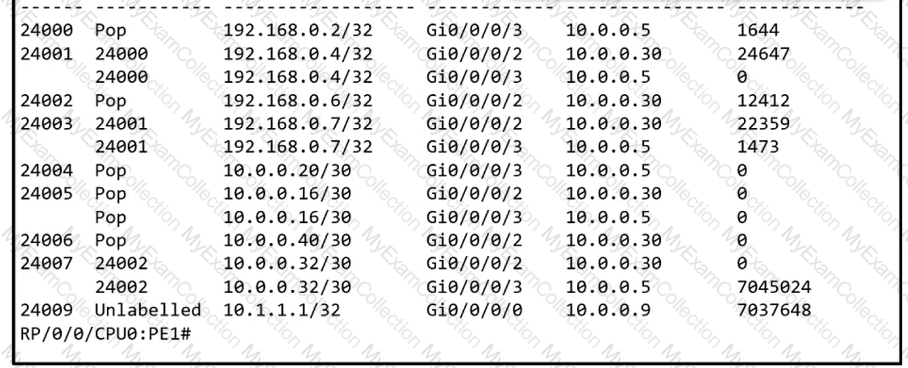
A network operator is troubleshooting packet loss seen from the R1 loopback interface to the R2 loopback interface over the core network. The operator is attempting to identify the next leg in the path from PE1. Which interface and label path should the operator investigate next?
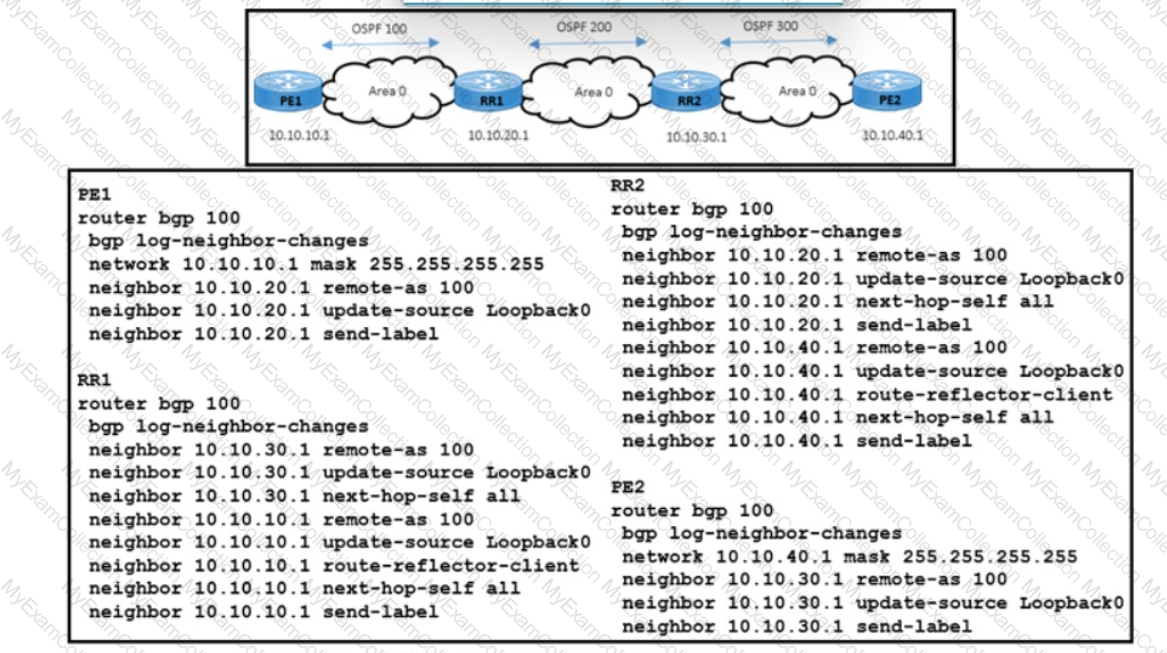
Refer to the exhibit. A network engineer is investigating a report of packet drops in an application running on a server connected to PE2 The engineer determined that:
- The OSPF adjacency in area 0 is up. and it is learning the loopback addresses of all routers in area 0.
- Traffic from users connected to PE1 to the application is also passing normally.
- Packets from PE2 back to PE1 are being dropped
Which action resolves the issue?
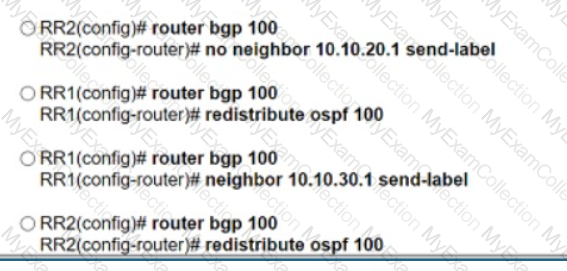
Refer to the exhibit.

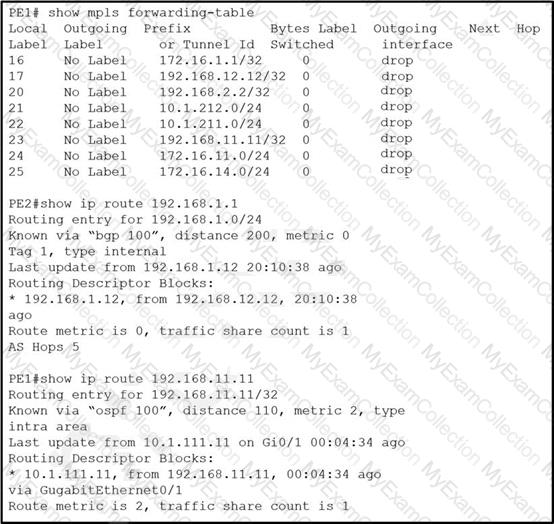
VPN users that are connected to PE routers are facing network issues. Traffic that originates from CE1 drops before reaching CE2. An engineer finds no outgoing traffic statistics on PE1 and PE2 routers toward CE devices and finds that the PE1 router is running the older software image. Which action must be implemented to resolve the issues?
In a PIM-SM environment, which mechanism determines the traffic that a receiver receives?

Refer to the exhibit. Router R1 is expected to receive routes that originate from AS 65547 only. However, R1 is receiving routes from AS 65547 and several other ASs that are directly attached to it. Which change to the AS path permit filter corrects the problem?
Compare different features between OSPFv2 and OSPFv3. Drag and drop the descriptions of OSPF from the left onto the correct OSPF versions on the right.
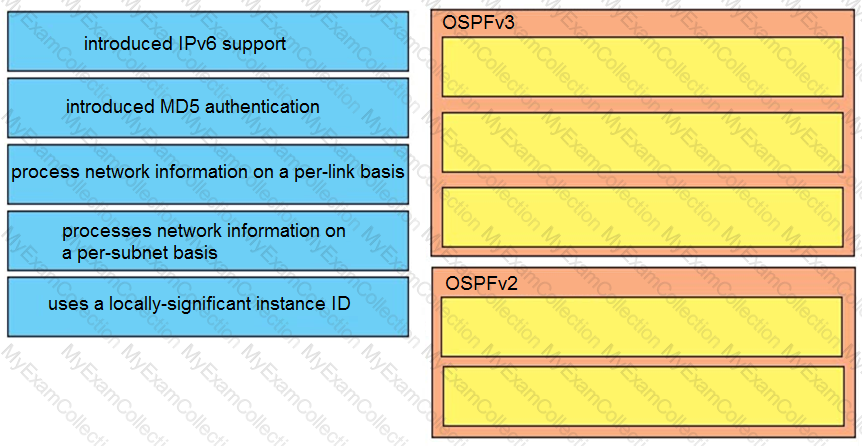
Drag and drop the attributes for the BGP route selection on the left into the correct order on the right. Not all options are used.
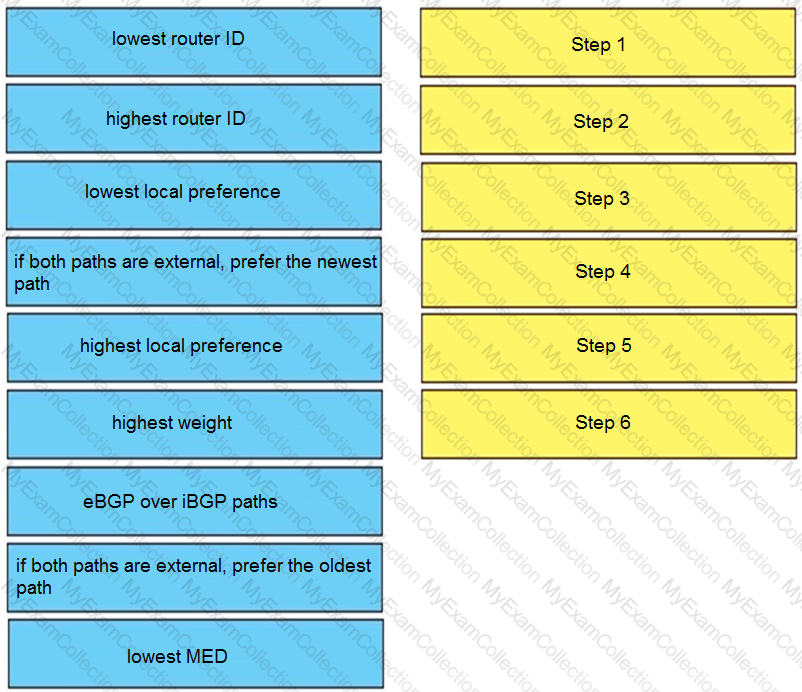
Drag and drop the route-manipulation methods from the left onto their features on the right
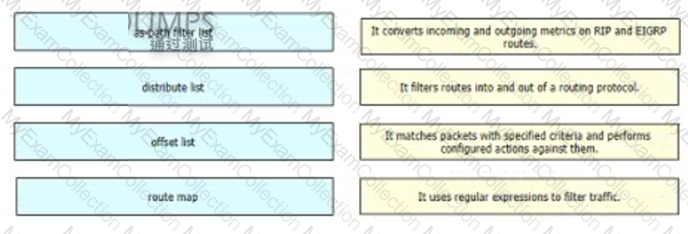
Refer to the exhibit
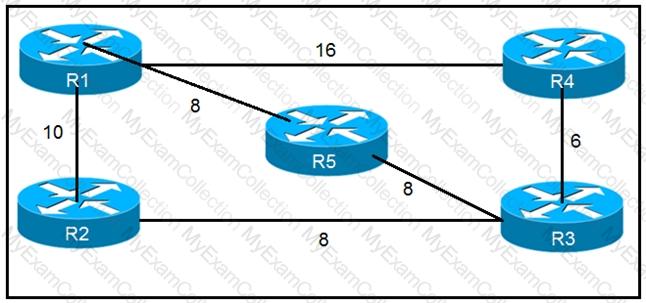
Which router does R1 install as an alternate next hop when trying to reach R3 if LFA is
enabled?
Refer to the exhibit.
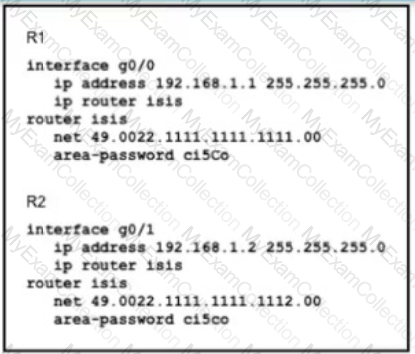
After these configurations were applied to routers R1 and R2. the two devices cannot form a neighbor relationship What is the reason tor the problem?
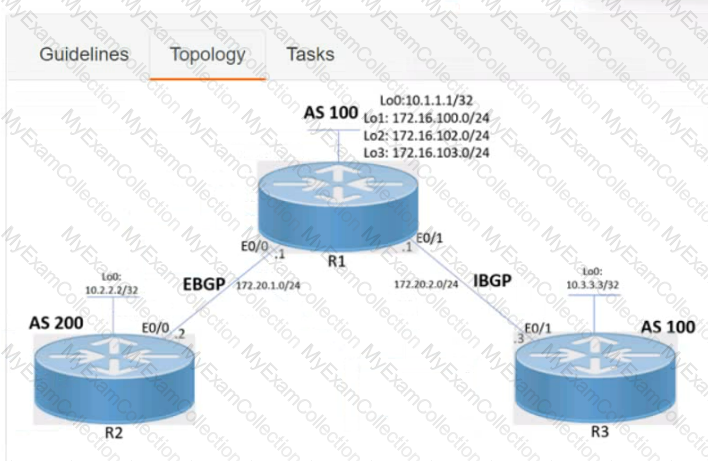
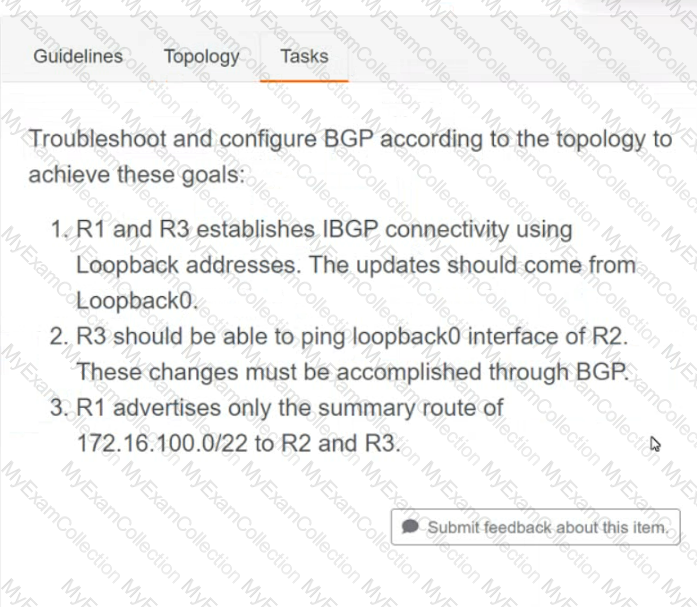
 Text
Description automatically generated
Text
Description automatically generated